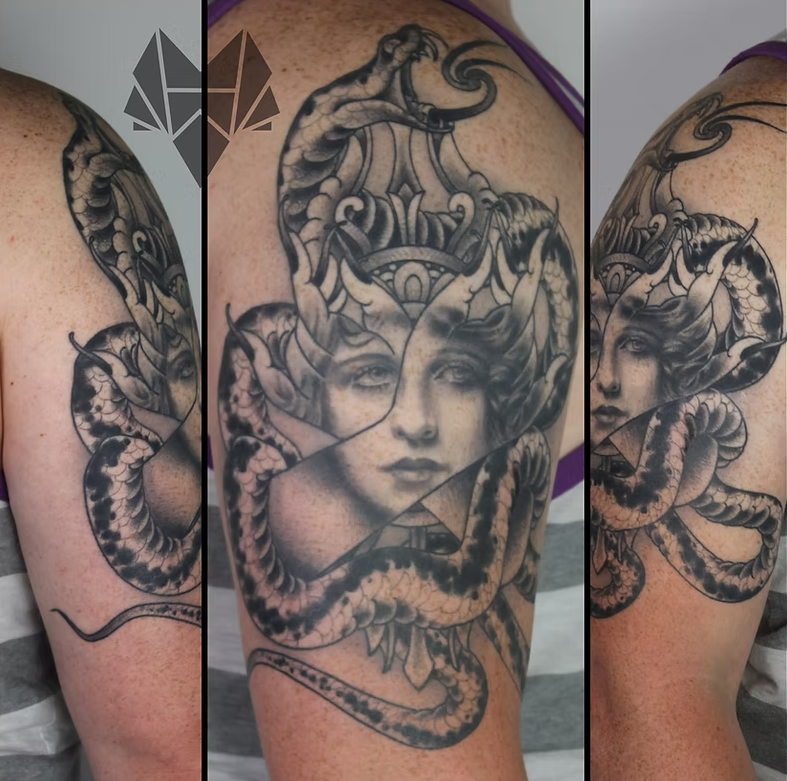What Is Traditional Tattoo Style: A Guide to Its Meaning and Origins
- Hannah wolf

- Aug 11
- 3 min read

A tattoo artist working with traditional styles draws from centuries of rich history and cultural meaning. This guide walks you through the fascinating world of traditional tattoos, from their ancient beginnings to their modern uses. You'll learn about the deep meanings behind popular designs, how different cultures shaped tattooing, and the special techniques that make these tattoos unique. We'll also look at how traditional styles have changed over time while keeping their original spirit alive.
Origins of Traditional Tattoo Style
Traditional tattoo styles started in ancient civilizations around the world, each with its own special meaning and art methods. In ancient Egypt, tattoos showed status and power, often worn by pharaohs and important officials. Polynesian cultures used tattoos to mark important life events and show spiritual beliefs, with detailed patterns representing gods or tribe connections. The Japanese tradition of irezumi goes back thousands of years, with full-body tattoos called horimono showing courage, honor, and strength. In the Western world, traditional American tattoos started in the 1700s, influenced by sailors who learned tattooing during their travels. Each culture's traditional tattoo style shows a rich mix of history, meaning, and artistic skill.
Symbolism in Traditional Tattoos
The meanings behind traditional tattoos help us understand the deep cultural stories and beliefs in these timeless art forms. Traditional tattoos are full of symbols, with each design carrying important meanings that show beliefs, values, and cultural background. Here are three key parts of symbolism in traditional tattoos:
Animal Symbolism: Animals like eagles, snakes, and tigers often mean strength, protection, and courage in traditional tattoo designs.
Floral Motifs: Flowers like roses, lotus, and cherry blossoms mean beauty, love, purity, and new beginnings in traditional tattoo art.
Nautical Symbols: Anchors, ships, and compasses mean guidance, stability, and life's journey in traditional nautical tattoos.
Cultural Influences on Tattooing
Different cultures have greatly shaped the art of tattooing, helping us understand the many practices and traditions that have contributed to the evolution of this ancient body art. Around the world, tattoos have different meanings and importance. In Polynesian cultures, tattoos connect deeply with spirituality and important life stages, showing strength, courage, and status. In Japan, traditional Irezumi tattoos are rich in meaning and often show folklore, legends, or historical events. Native American communities use tattoos to connect with their heritage and tell stories of their people. These different cultural influences not only shape tattoo designs and meanings but also reflect the deep traditions and beliefs of each society.
Evolution of Traditional Tattoo Art
Over time, traditional tattoo art has changed in amazing ways, showing the changing cultures and artistic styles of different societies. As this art form has grown, it has been influenced by social norms, new technology, and global influences, shaping how it has developed over time. Understanding how traditional tattoos developed requires looking at these key parts:
Migration Patterns: How people moving across regions influenced the spread and changes of traditional tattoo styles.
Artistic Innovations: The role of famous tattoo artists in pushing the limits of traditional designs and techniques.
Social Significance: How traditional tattoos have changed in their cultural meanings and how society sees them throughout different periods.
Techniques Used in Traditional Tattoos
Movement patterns have played a big role in influencing the techniques used in traditional tattoos, shaping the unique styles seen across different cultures and regions. Polynesian tattooing techniques use sharp bone or metal tools to hand-tap ink into the skin, creating detailed geometric designs. In Japan, the traditional tebori method uses long bamboo sticks with needles attached to create bold and detailed patterns. In Southeast Asia, hand-tapping techniques using a tool called a 'sak yant' are used for sacred designs. Each culture's unique approach to tattooing shows not only artistic expression but also historical stories and spiritual importance, displaying the rich traditions passed down through generations.
Modern Interpretations of Traditional Tattoos
In today's tattoo world, new takes on traditional tattoo styles have appeared, mixing old techniques with modern ideas to create a blend of cultural heritage and personal expression. Modern versions of traditional tattoos have started a revolution in the tattoo industry, bringing together the past with the present to create unique and meaningful body art. Here are three key things to consider:
Mixing traditional designs with modern style elements
Using bright colors and detailed shading techniques
Adding personal meaning and stories to traditional tattoo themes
These modern versions bring new life to old practices, offering a fresh view of the rich history and cultural importance of traditional tattoos.
Related Topics:




Comments